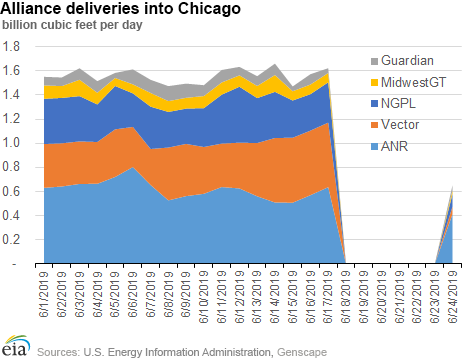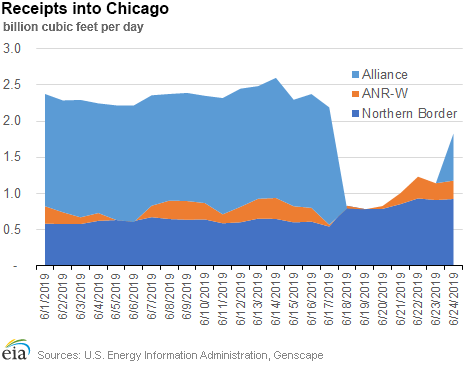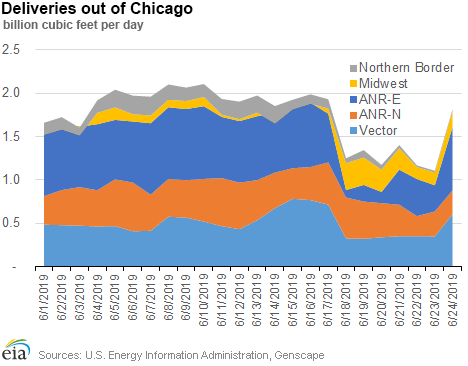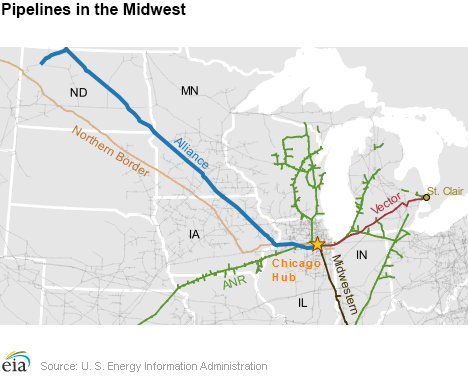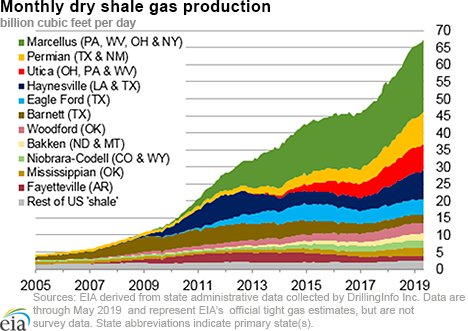The next release for Natural Gas Weekly Update will be on July 11, 2019, as a result of the July 4 federal holiday.
In the News:
Critical notice on the Alliance pipeline rearranges flows in Midwest
The Alliance Pipeline posted a critical notice announcing zero flows on the line between Tuesday, June 18, and Friday, June 21, 2019, to perform pipeline repairs in Iowa and Illinois. Alliance typically imports about 1.7 billion cubic feet per day (Bcf/d) of natural gas from Western Canada into the United States through Sherwood, North Dakota, and delivers into Midwestern markets. The pipeline also feeds several interstate pipelines, in particular ANR and Vector pipelines. Despite the magnitude of this event, the region met customer demand using alternative supply options and storage access, and as a result, prices were not significantly affected. Sherwood, North Dakota is the second-largest receipt point for imports from Canada after Eastport, Idaho, which brings natural gas into the Pacific Northwest on TC Energy’s (formerly TransCanada) Gas Transmission Northwest system.
Genscape data show that Alliance deliveries into North Dakota were zero or very close to zero for six days, encompassing Tuesday, June 18 through Sunday, June 23. On Monday June 24, flows resumed to 1.6 billion cubic feet per day (Bcf/d), which is close to normal levels. As a result of the outages, supplies into ANR and Vector were reduced, which also reduced exports into Canada on the Vector pipeline at St. Clair, Michigan.
In the days leading up to the outage, flows on Vector increased compared to earlier in the month, reaching about 800 million cubic feet per day (MMcf/d) before dropping by about 50% after Alliance’s outage. Similarly, flows on ANR-East out of Chicago fell by almost 50% on average during the outage. Platts S&P Global storage data show that ANR, which is one of the largest storage operators in the region, had an unusually large injection of 7.2 Bcf for the week ending June 14 and a smaller injection of 5.9 Bcf for the week ending June 21. In addition, receipts from the Northern Border pipeline increased by about 300 MMcf/d during the outage to help supplement missing volumes. Northern Border imports natural gas at Port of Morgan, Montana, the nation’s third-largest pipeline import point, and also receives some volumes from production basins in Wyoming.
Between Friday, June 14, and Monday, June 17, prices in the Midwest appear to have jumped by 10 cents to 20 cents per million British thermal unit (MMBtu). However, prices at the Chicago Citygate remained near $2.20/MMBtu in the days following the shut-in, declining toward the end of the event. As of Monday, June 24, the Chicago Citygate price traded at $1.91/MMBtu. This price level indicates that the reduced supply on Alliance was more than offset by supply from other regions, as well as mild weather and high production levels.
Overview:
(For the week ending Wednesday, June 26, 2019)
- Natural gas spot prices fell at most locations this report week (Wednesday, June 19 to Wednesday, June 26). Henry Hub spot prices fell from $2.36 per million British thermal units (MMBtu) last Wednesday to $2.32/MMBtu yesterday.
- At the New York Mercantile Exchange (Nymex), the July 2019 contract expired yesterday at $2.291/MMBtu, up 2¢/MMBtu from last Wednesday. The August 2019 contract remained unchanged Wednesday to Wednesday at $2.268/MMBtu. The price of the 12-month strip averaging August 2019 through July 2020 futures contracts declined 1¢/MMBtu to $2.446/MMBtu.
- Net injections to working gas totaled 98 billion cubic feet (Bcf) for the week ending June 21. Working natural gas stocks are 2,301 Bcf, which is 11% more than the year-ago level and 7% lower than the five-year (2014–18) average for this week.
- The natural gas plant liquids composite price at Mont Belvieu, Texas, rose by 30¢/MMBtu, averaging $4.50/MMBtu for the week ending June 26. The price of isobutane, natural gasoline, butane, and propane rose by 19%, 10%, 9%, and 7%, respectively. The price of ethane fell by 2%.
- According to Baker Hughes, for the week ending Tuesday, June 18, the natural gas rig count decreased by 4 to 177. The number of oil-directed rigs rose by 1 to 789. The total rig count decreased by 2, and it now stands at 967.
Prices/Supply/Demand:
Prices generally fall across the country amid cool temperatures. This report week (Wednesday, June 19 to Wednesday, June 26), Henry Hub spot prices fell 4¢ from $2.36/MMBtu last Wednesday to $2.32/MMBtu yesterday, with a low of $2.20/MMBtu on Friday. Temperatures were generally cooler than normal across most of the country, especially west of the Rocky Mountains; temperatures were slightly warmer than normal in the Southeast. At the Chicago Citygate, prices decreased 8¢ from $2.18/MMBtu last Wednesday to $2.10/MMBtu yesterday.
California prices fall. Prices at PG&E Citygate in Northern California fell 23¢, down from $2.70/MMBtu last Wednesday to $2.47/MMBtu yesterday. Prices at SoCal Citygate decreased 44¢ from $2.40/MMBtu last Wednesday to $1.96/MMBtu yesterday. Prices traded within a relatively wide range of $1.26/MMBtu during the report week in Southern California with SoCalGas’s June 19 announcement that working natural gas inventory at Aliso Canyon has reached its authorized maximum level of 34 Bcf.
Northeast prices remain relatively flat and below Henry Hub prices. At the Algonquin Citygate, which serves Boston-area consumers, prices went up 4¢ from $2.17/MMBtu last Wednesday to a weekly high of $2.21/MMBtu yesterday with forecasts of warmer temperatures for the next report week. At the Transcontinental Pipeline Zone 6 trading point for New York City, prices decreased 1¢ from $2.19/MMBtu last Wednesday to $2.18/MMBtu yesterday, with a low of $1.98/MMBtu on Friday.
Tennessee Zone 4 Marcellus spot prices increased 3¢ from $1.98/MMBtu last Wednesday to $2.01/MMBtu yesterday. Prices at Dominion South in southwest Pennsylvania fell 3¢ from $2.04/MMBtu last Wednesday to $2.01/MMBtu yesterday.
Permian Basin prices trade in positive territory throughout the report week. Prices at the Waha Hub in West Texas, which is located near Permian Basin production activities, averaged $0.19/MMBtu last Wednesday, $2.17/MMBtu lower than Henry Hub prices. Yesterday, prices at the Waha Hub averaged $0.22/MMBtu, $2.10/MMBtu lower than Henry Hub prices. Although prices remained in positive territory throughout the report week, they remained relatively low as a result of limited takeaway capacity, reaching a high of $0.50/MMBtu on Tuesday.
Supply is flat. According to data from PointLogic Energy, the average total supply of natural gas remained the same as in the previous report week, averaging 94.2 Bcf/d. Dry natural gas production grew by 1% compared with the previous report week. Average net imports from Canada decreased by 2% from last week. Rising dry natural gas production compensated for lower Canadian imports that were the result of a shutdown on the 1.8 Bcf/d Alliance pipeline (see article above), which resumed flows on Monday, June 24.
Demand increases are driven by the electric power sector. Total U.S. consumption of natural gas rose by 4% compared with the previous report week, according to data from PointLogic Energy. Natural gas consumed for power generation climbed by 8% week over week amid temperatures that were slightly warmer than normal in the Southeast region, where electricity is used for cooling demand. Industrial sector consumption decreased by 2% week over week. In the residential and commercial sectors, consumption declined by 1%. Natural gas exports to Mexico were the same as last report week, averaging 5.2 Bcf/d.
U.S. LNG exports decrease week over week. Eight LNG vessels (six from Sabine Pass, one from Corpus Christi, and one from Cove Point) with a combined LNG-carrying capacity of 28 Bcf departed the United States between June 20 and June 26, according to shipping data compiled by Bloomberg. On Wednesday, one vessel was loading at the Sabine Pass terminal, one at Corpus Christi, and one at the Cameron terminal.
Storage:
Net injections into storage totaled 98 Bcf for the week ending June 21, compared with the five-year (2014–18) average net injections of 70 Bcf and last year's net injections of 71 Bcf during the same week. Working gas stocks totaled 2,301 Bcf, which is 171 Bcf lower than the five-year average and 236 Bcf more than last year at this time.
According to The Desk survey of natural gas analysts, estimates of the weekly net change from working natural gas stocks ranged from net injections of 95 Bcf to 111 Bcf, with a median estimate of 100 Bcf.
The average rate of net injections into storage is 39% higher than the five-year average so far in the refill season (April through October). If the rate of injections into storage matched the five-year average of 9.2 Bcf/d for the remainder of the refill season, total inventories would be 3,521 Bcf on October 31, which is 171 Bcf lower than the five-year average of 3,692 Bcf for that time of year.
More storage data and analysis can be found on the Natural Gas Storage Dashboard and the Weekly Natural Gas Storage Report.
See also:
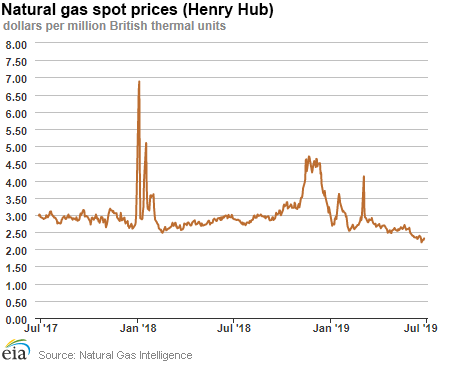
| Spot Prices ($/MMBtu) | Thu, 20-Jun |
Fri, 21-Jun |
Mon, 24-Jun |
Tue, 25-Jun |
Wed, 26-Jun |
|---|---|---|---|---|---|
| Henry Hub |
2.32 |
2.20 |
2.28 |
2.28 |
2.32 |
| New York |
2.05 |
1.98 |
2.07 |
2.15 |
2.18 |
| Chicago |
2.09 |
1.91 |
2.04 |
2.10 |
2.10 |
| Cal. Comp. Avg.* |
1.97 |
1.21 |
2.23 |
2.13 |
2.03 |
| Futures ($/MMBtu) | |||||
| July contract | 2.185 |
2.186 |
2.303 |
2.308 |
2.291 |
| August contract |
2.166 |
2.169 |
2.284 |
2.286 |
2.268 |
| *Avg. of NGI's reported prices for: Malin, PG&E Citygate, and Southern California Border Avg. | |||||
| Sources: Natural Gas Intelligence and CME Group as compiled by Bloomberg, L.P. | |||||
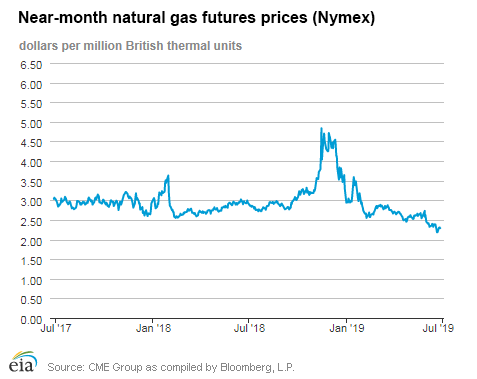
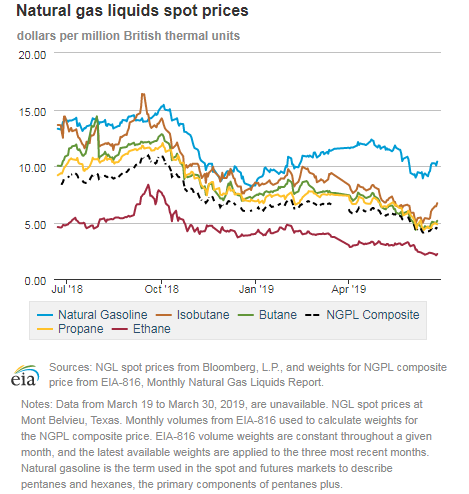
| U.S. natural gas supply - Gas Week: (6/20/19 - 6/26/19) | |||
|---|---|---|---|
Average daily values (Bcf/d): |
|||
this week |
last week |
last year |
|
| Marketed production | 100.4 |
99.8 |
92.2 |
| Dry production | 89.6 |
89.0 |
81.8 |
| Net Canada imports | 4.6 |
4.7 |
5.8 |
| LNG pipeline deliveries | 0.1 |
0.1 |
0.1 |
| Total supply | 94.2 |
93.8 |
87.7 |
|
Source: OPIS PointLogic Energy, an IHS Company | |||
| U.S. natural gas consumption - Gas Week: (6/20/19 - 6/26/19) | |||
|---|---|---|---|
Average daily values (Bcf/d): |
|||
this week |
last week |
last year |
|
| U.S. consumption | 67.0 |
64.7 |
62.8 |
| Power | 36.6 |
33.8 |
32.8 |
| Industrial | 20.9 |
21.3 |
21.3 |
| Residential/commercial | 9.5 |
9.6 |
8.7 |
| Mexico exports | 5.2 |
5.2 |
4.4 |
| Pipeline fuel use/losses | 6.2 |
6.1 |
5.7 |
| LNG pipeline receipts | 5.8 |
5.5 |
3.4 |
| Total demand | 84.1 |
81.4 |
76.3 |
|
Source: OPIS PointLogic Energy, an IHS Company | |||
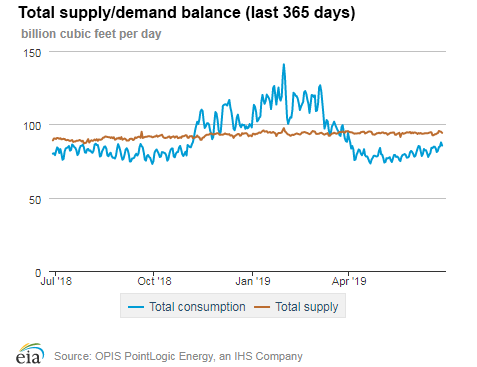
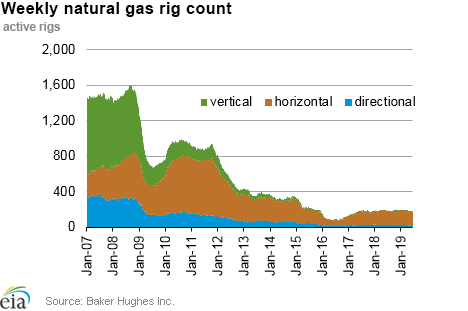
| Rigs | |||
|---|---|---|---|
Tue, June 18, 2019 |
Change from |
||
last week |
last year |
||
| Oil rigs | 789 |
0.1% |
-8.5% |
| Natural gas rigs | 177 |
-2.2% |
-5.9% |
| Note: Excludes any miscellaneous rigs | |||
| Rig numbers by type | |||
|---|---|---|---|
Tue, June 18, 2019 |
Change from |
||
last week |
last year |
||
| Vertical | 53 |
8.2% |
-11.7% |
| Horizontal | 846 |
-0.7% |
-9.0% |
| Directional | 68 |
0.0% |
9.7% |
| Source: Baker Hughes Inc. | |||
| Working gas in underground storage | ||||
|---|---|---|---|---|
Stocks billion cubic feet (Bcf) |
||||
| Region | 2019-06-21 |
2019-06-14 |
change |
|
| East | 499 |
472 |
27 |
|
| Midwest | 538 |
503 |
35 |
|
| Mountain | 127 |
118 |
9 |
|
| Pacific | 245 |
234 |
11 |
|
| South Central | 893 |
875 |
18 |
|
| Total | 2,301 |
2,203 |
98 |
|
|
Source: Form EIA-912, Weekly Underground Natural Gas Storage Report | ||||
| Working gas in underground storage | |||||
|---|---|---|---|---|---|
Historical comparisons |
|||||
Year ago (6/21/18) |
5-year average (2014-2018) |
||||
| Region | Stocks (Bcf) |
% change |
Stocks (Bcf) |
% change |
|
| East | 427 |
16.9 |
510 |
-2.2 |
|
| Midwest | 422 |
27.5 |
555 |
-3.1 |
|
| Mountain | 132 |
-3.8 |
156 |
-18.6 |
|
| Pacific | 250 |
-2.0 |
282 |
-13.1 |
|
| South Central | 834 |
7.1 |
969 |
-7.8 |
|
| Total | 2,065 |
11.4 |
2,472 |
-6.9 |
|
| Source: Form EIA-912, Weekly Underground Natural Gas Storage Report | |||||
| Temperature – heating & cooling degree days (week ending Jun 20) | ||||||||
|---|---|---|---|---|---|---|---|---|
HDD deviation from: |
CDD deviation from: |
|||||||
| Region | HDD Current |
normal |
last year |
CDD Current |
normal |
last year |
||
| New England | 12 |
2 |
7 |
7 |
-8 |
-20 |
||
| Middle Atlantic | 5 |
-2 |
3 |
22 |
-7 |
-27 |
||
| E N Central | 18 |
9 |
16 |
15 |
-21 |
-55 |
||
| W N Central | 10 |
1 |
9 |
33 |
-14 |
-54 |
||
| South Atlantic | 2 |
1 |
2 |
81 |
4 |
-21 |
||
| E S Central | 3 |
3 |
3 |
71 |
-1 |
-32 |
||
| W S Central | 0 |
0 |
0 |
103 |
-1 |
-15 |
||
| Mountain | 10 |
-9 |
3 |
57 |
1 |
0 |
||
| Pacific | 4 |
-11 |
-4 |
22 |
-2 |
2 |
||
| United States | 8 |
0 |
5 |
46 |
-5 |
-25 |
||
|
Note: HDD = heating degree day; CDD = cooling degree day Source: National Oceanic and Atmospheric Administration | ||||||||
Average temperature (°F)
7-day mean ending Jun 20, 2019
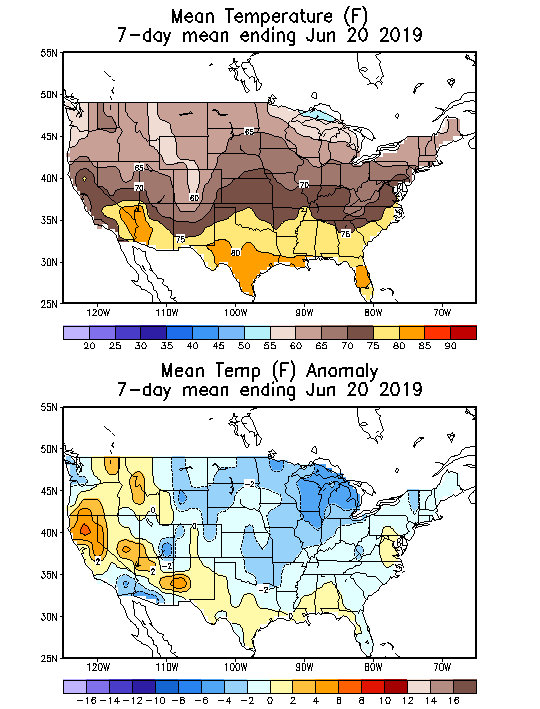
Source: National Oceanic and Atmospheric Administration
Deviation between average and normal (°F)
7-day mean ending Jun 20, 2019

Source: National Oceanic and Atmospheric Administration

